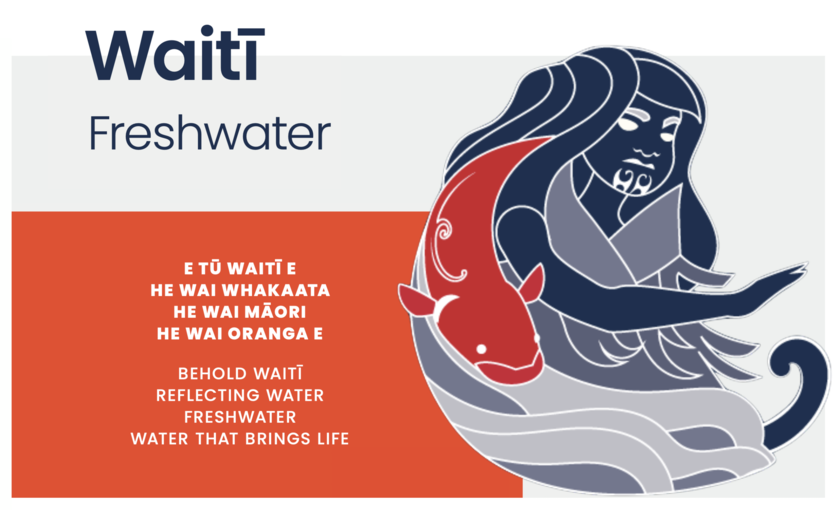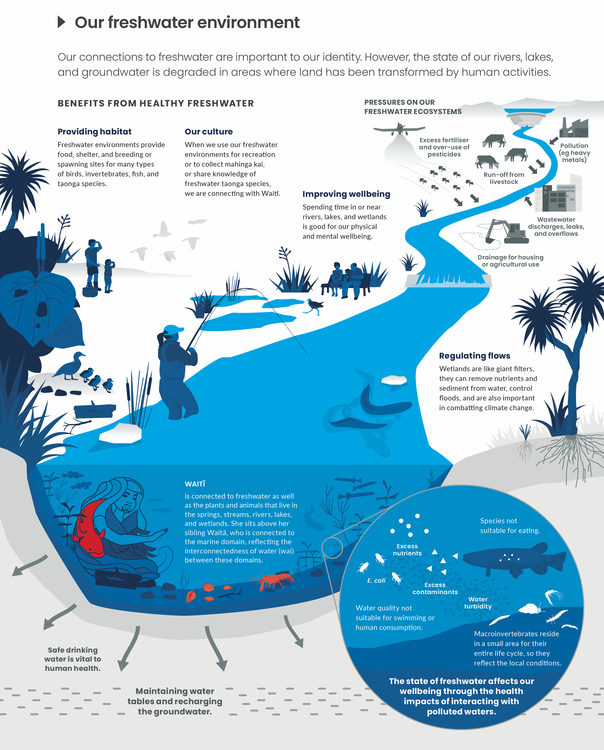Waitī is a whetū in the Matariki cluster. It is the star connected to freshwater: springs, streams, rivers, lakes, wetlands and the plants and animals that live in freshwater.
Aotearoa New Zealand’s Ministry for the Environment and Stats NZ have produced Environment Aotearoa 2022 as part of its environmental reporting series. Environment Aotearoa 2022 has a unique approach that uses Te Kāhui o Matariki as the guiding framework for the report. Learn more about this approach in the article Environment Aotearoa 2022 – introduction.
In Environment Aotearoa 2022, Waitī represents our essential connection to freshwater and how we are impacted by the degraded state of many of our freshwater environments. The mauri concept for Waitī links the health of freshwater to everything that is connected to it.
Waitī is comprised of two words wai (water) and tī which means sweet. Waitī is linked to Parawhenuamea, atua of freshwater and Rakahore, the personification of the rocks.
Environment Aotearoa 2022
Mauri, mahinga kai and manaakitanga
In te ao Māori, the human and non-human worlds are indivisible. There are kinship relationships and therefore responsibilities towards natural features, including freshwater (wai Māori). A healthy mauri is a sign that an awa is expressing its mana, or spiritual power. One indicator of the health of the waters and the people and the close links between them is the ability to fish and harvest food. Mahinga kai refers to the practices of gathering food, tools and other resources across the realms of land, marine and freshwater.
The ability to collect these resources affects the mana of an iwi or hapū, as they contribute to their capacity for manaakitanga – offering food from their whenua and wai to invited guests – an important part of hospitality. The protection of taonga species important to mahinga kai also protects and maintains te reo Māori, tikanga and mātauranga Māori – the language, practices and knowledge that are associated with them. For example, repo (wetlands) are reservoirs of mātauranga Māori and places of deep historical, economic and spiritual significance.
Recreation, energy and health
Access to unpolluted water for drinking and recreation is vital for our health. The article Tupuārangi – land-based ecosystems reflects on the importance of greenspaces to our mental and physical wellbeing. Spending time near blue spaces, such as rivers, lakes and the sea, has similar benefits. Aotearoa is a nation of swimmers, boaters and anglers. Blue spaces also provide the opportunity for social connection when communities work together on projects like stream restoration.
Freshwater is essential to electricity generation. Our hydro dams account for 55–60% of electricity generation each year. One downside to this renewable energy source is how dams alter rivers and the surrounding catchment areas. The mauri of the river is adversely impacted when it is unable to flow unobstructed from the mountains to the sea – the spiritual significance to iwi rests in the river as a whole.
Water quality in Aotearoa
Human activities are degrading our rivers, lakes and groundwater with many lake and river sites scoring poorly in terms of water quality. The article Pōhutukawa – pressures on the environment discusses land use changes and intensification and the impacts this has on te taiao. Many of our lakes and rivers have unnaturally high levels of nutrients, which can come from urban or agricultural run-off. The article Tupuānuku – land and soil reports on erosion – sediments that lower water clarity and increase turbidity. Nutrient pollution and water turbidity affect macroinvertebrates – insects and worms that form an important part of freshwater food webs.
Polluted waterways also affect the connections humans have with Waitī. Water quality is especially important for drinking water and for recreational activities like swimming and kayaking.
Enhancing freshwater health
Environment Aotearoa 2022 recognises that properly assessing the health of freshwater requires a holistic view. Ki uta ki tai (from the mountains to the sea) is an approach to freshwater management based on Māori knowledge and practice. Download this section of the report as a PDF.
The report also notes that we can enhance our wellbeing by restoring threatened freshwater ecosystems. These resources provide help with the restoration process:
- Monitoring stream health
- Wetland restoration
- Te whakamahi i ngā rauemi o Tuihonoa Te Reo o Te Repo hei whakarite ara whakaako
- New Zealand’s freshwater fish – action conservation (resources in te reo Māori and English)
Taking action enables us to feel empowered and that we can make a positive difference to restoring and connecting to freshwater waterways and ecosystems.
Related content
The Hub has extensive resources on water quality and freshwater ecosystem restoration. Explore these curations:
- Rivers and Us – introduction – exploring how people use water, the effects on water quality and investigation and data collection to inform action.
- Tōku awa koiora – introduction – exploring the restoration of the Waikato River.
- Repo (wetlands) – exploring ecological and cultural values, and taking action to understand, protect or restore local repo.
- Tuihonoa Te Reo o Te Repo – he kohinga rauemi pāhekoheko a Tuihonoa Te Reo o Te Repo hei āwhina i ngā kaiako ki te whakatītina i ngā ākonga kia tū hei kaitiaki mō ngā repo. E whai ana hoki kia tū tiketike mai te mātauranga Māori, mā roto i ngā mahi whakaora taiao.
- New Zealand’s freshwater fish – introduction – exploring our unique native fish, their habitats and suggestions on what we can do to help conserve this taonga (resources in te reo Māori and English).
- Lakes380 – Our lakes’ health: past, present, future – find out about the largest scientific study ever undertaken of lakes in Aotearoa.
- Explore Mahinga kai to find out about taonga species connected to Waitī.
Aotearoa has abundant freshwater resources. The Hub has an abundance of freshwater resources too. We’ve got them organised in this handy interactive, complete with a PLD article to get you started!
Palaeo-ecology, archaeology and matāuranga Māori share philosophies of learning from the past. Could this lead to the resumption of traditional harvesting practices of some native species?
Explore the range of resources in our Freshwater – lakes and rivers Pinterest Board.
The Science Learning Hub team has curated a collection of resources to support Matariki and Environment Aotearoa 2022. This collection provides additional context and pedagogical insights. Log in to make this collection part of your private collection, just click on the copy icon. You can then add additional content and notes and make other changes.
Related activity
Use this activity to explore freshwater issues and tuna heke (eel migration) from the perspective of a migrating eel.
Useful links
Stats NZ and the Ministry for the Environment report on different aspects of Aotearoa New Zealand’s environment every 6 months. Access their reports here.
Our freshwater 2020 examines the most pressing issues on our freshwater. The report is produced jointly by the Ministry for the Environment and Stats NZ.
Visit Stats NZ for more information on water quality indicators:
- Cultural health index for freshwater bodies
- Lake water quality
- River water quality: Escherichia coli
- River water quality: phosphorus
- River water quality: nitrogen
- River water quality: macroinvertebrate community index
- River water quality: clarity and turbidity
- Wetland area
- Groundwater quality
See the articles in the New Zealand Journal of Marine and Freshwater Research 2018 Special Issue: Mātauranga Māori shaping marine and freshwater futures. In particular these articles:
- Classifying the mauri of wai in the Matahuru Awa in North Waikato
- Māori oral traditions record and convey indigenous knowledge of marine and freshwater resources
Maramataka expert Rereata Makiha discusses world views, tohu and resilience in this presentation to Te Wai Māori Freshwater Fisheries Conference 2019.
Acknowledgement
This resource has been produced in collaboration with the Ministry for the Environment and Stats NZ.



